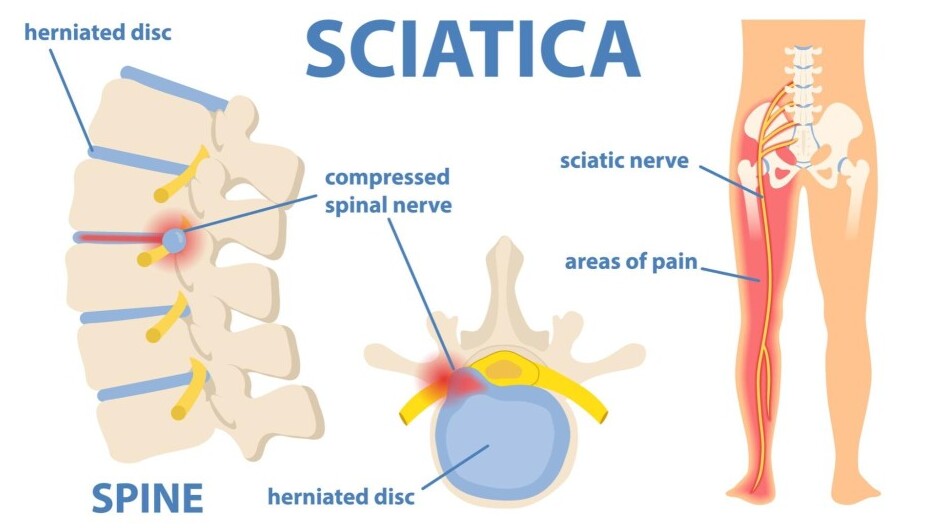Sciatica pain can throw your entire day off balance. Instead of moving confidently, you may hesitantly take each step because of that sharp, shooting sensation running from your lower back down your leg.
Having dealt with my own aches in the past, I totally get the frustration and urgency of tracking down real solutions that make a difference. So, what ia the best treatment for sciatica pain in the elderly ?
Here’s what I’ve picked up about sciatica treatments, along with tips for making them work better for fast, effective relief.

Understanding Sciatica Pain and How It Starts
Sciatica isn’t actually a stand-alone condition. Instead, it’s a term that describes nerve pain traveling down the leg, typically from irritation of the sciatic nerve. Most commonly, this pain happens due to a herniated disc pressing on the nerve, but spinal stenosis, piriformis syndrome, and bone spurs can also be culprits. If you’re feeling pain, tingling, burning, or even weakness in your leg, especially after sitting or standing, sciatica might be the reason.
The pain often flares after lifting heavy objects, twisting quickly, or sitting for long stretches. Basically, anything that puts extra pressure on the lower spine or nearby muscles can spark it. Sciatica is very common. The Cleveland Clinic notes that up to 40% of people deal with it at some point in their lives (Cleveland Clinic: Sciatica).
First Steps: At-Home Relief for Sciatica Pain
When my own sciatica started acting up, I turned to home remedies first. For most people, sciatica improves within a few weeks by keeping things simple. Here are some go-to methods you can try at home:
- Heat and Cold Packs: Start with cold packs on your lower back for twenty minutes, several times a day. Switch to a heating pad after two or three days. The cold can ease inflammation, and then heat helps relax your muscles.
- Gentle Movement: While bed rest sounds tempting, too much of it can worsen symptoms. Moving (carefully) keeps nerves and muscles flexible instead of letting them tighten up.
- Over the Counter Pain Relief: Non prescription medicines like ibuprofen or acetaminophen can reduce pain enough for you to stay moving and get things done.
- Stretches: Simple stretches for your lower back, hamstrings, and glutes feel amazing. Don’t force anything; keep the movements gentle and steady.
Sticking with these basic treatments helps many people bounce back from the worst pain in a week or two. If you’re searching for reliable routines, check out the Spine-Health sciatica exercise page for safe stretches and movement ideas.
When To See a Healthcare Provider About Sciatica
Mild sciatica often clears up with at-home care, but sometimes you need to visit a doctor. If your pain lingers more than several weeks or is very intense, a medical check up helps rule out bigger problems. You should ask a professional if:
- Pain doesn’t improve or is getting worse
- Numbness, weakness, or issues moving your leg develop or intensify
- There are changes in bowel or bladder control (this calls for quick medical attention)
Physical therapists, chiropractors, and pain specialists can all provide expert guidance when the pain sticks around. They’ll show you moves to help your nerve relax, teach smart strategies for your daily routine, and talk about other treatment options if you need them.
Best Medical Treatments: When Home Remedies Aren’t Enough
If home care isn’t cutting it or your sciatica keeps coming back, medical treatments are the next move. Here’s what health professionals often recommend and what’s worked for many patients:
- Physiotherapy: A physical therapist tailors exercises for your body and helps you find smart fixes for your posture and daily movements. They will also advise on exercises to help treat and relieve the pain of sciatica. Over time, this makes a huge difference in finding long-term relief to your problem.
- Prescription Medications: Sometimes, stronger pain relievers or anti-inflammatory drugs are necessary if store-bought options don’t do enough. Muscle relaxants or nerve pain medications like gabapentin can also help.
- Epidural Steroid Injections: These steroid injections into the spine are designed to cut down on swelling around the sciatic nerve. Relief might last from a few weeks to a few months, buying you time to heal and build strength through rehab.
- Manual Therapy: Some chiropractors and osteopaths use hands-on techniques to relieve pressure and get everything moving better.
Surgery is a last resort. It’s rarely needed but sometimes required if nothing else helps and nerve pressure is causing serious or prolonged problems. Procedures like microdiscectomy or laminectomy are used to take pressure off the nerve.

Tips to Prevent Sciatica Flare-Ups
Avoiding future flare-ups is always the goal after your first painful episode. Simple habits can make a huge difference in keeping the pain at bay:
- Keep your core muscles strong; core strength puts less load on your spine
- Maintain good posture when sitting and standing
- Lift using your legs instead of your back to protect your spine
- Pick supportive shoes and choose ergonomic seating if you spend a lot of time sitting
- Take movement breaks and do light stretches if you’re in one position for long periods
Bringing these habits into daily life reduces the odds of another painful episode. For long-term prevention, steady low impact activities like walking, cycling, or swimming help your back stay healthy and ready for anything.
What to Consider When Choosing a Sciatica Treatment
With dozens of treatment choices available, picking the right option can get confusing fast. Here are some questions and tips that helped me narrow things down:
- Severity and Cause: The best approach hinges on what’s really triggering your pain. Herniated discs, for example, might need different attention than issues caused by tight muscles or piriformis syndrome.
- Your Health History: Something perfect for someone else may not be safe if you’ve got another condition like arthritis or cardiovascular problems. Always check in with your healthcare provider before starting anything new.
- Recovery Goals: Quick pain relief is nice, but lasting comfort usually takes a blended approach, with strength, flexibility, and proper movement all in the mix.
- Lifestyle Needs: Not everyone can see specialists every week. Home exercise plans and telehealth options can be just right for busy folks who need flexibility.
By researching, weighing your needs, and talking with your doctor, you can craft a plan that sets you up for both short-term comfort and long-lasting back health.

FAQ: Sciatica Pain and Treatment
People have thousands of questions each month about sciatica. Here are a few common ones—and what I’ve found out along the way:
How long does sciatica pain usually last ?
Most cases of sciatica improve in a few weeks, particularly with gentle movement and home therapy. If you’re still miserable after a month, a doctor can help figure out any underlying causes or recommend a targeted plan.
Are there any treatments to avoid for sciatica?
Be careful about miracle cures or treatments that only promise fast results. Aggressive spinal manipulations or strong pain medications can sometimes do more harm than good, so stick to options that come from trusted medical sources or providers.
Does exercise help sciatica pain?
Yes. Gentle, regular movement and stretches speed up recovery and help keep pain from coming back. Avoid high-impact activities or exercises that trigger sharp pain, but keep your body in motion as much as you comfortably can.
The Bottom Line: Finding the Best Sciatica Treatment
The best approach for sciatica depends on the cause, your health background, and what fits your life. For most people, a blend of home care, smart movement, and input from health professionals gives steady relief and sets you up for long-term success.
Good habits, stretching, and smart medical advice combine for a plan that can tackle pain now and protect you in the future. When sciatica strikes, don’t hesitate to test different strategies, pay attention to your body, and talk to a doctor if things aren’t getting better. Your back and your legs will be grateful.
